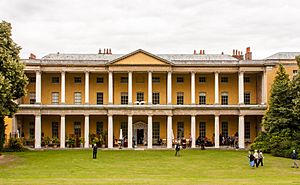Sir Francis Dashwood, 1st Baronet facts for kids
Quick facts for kids
Sir Francis Dashwood, Bt
|
|
|---|---|
| Member of Parliament for Winchelsea | |
| In office 1708–1713 Serving with George Dodington, Robert Bristow
|
|
| Preceded by | James Hayes George Dodington |
| Succeeded by | Robert Bristow George Dodington |
| Personal details | |
| Born | c. 1658 |
| Died | 4 November 1724 (aged 65–66) |
| Spouses |
Mary Jennings
(m. 1683; died 1694)Lady Mary Fane
(m. 1705; Mary King
(m. 1712; died 1717)Lady Elizabeth Windsor
(m. 1720) |
| Relations | Samuel Dashwood (brother) Sir Robert Dashwood, 1st Baronet (cousin) Sir John Dashwood-King, 4th Baronet (grandson) |
| Children | Francis Dashwood, 11th Baron le Despencer Sir John Dashwood-King, 3rd Baronet |
Sir Francis Dashwood, 1st Baronet (born around 1658 – died 4 November 1724) was an important person in British history. He lived in London and West Wycombe, Buckinghamshire. Sir Francis was a successful merchant and landowner. He was also a Whig politician. He served in the House of Commons, which is part of the British Parliament, from 1708 to 1713.
Contents
Early Life of Francis Dashwood
Francis Dashwood was the third son in his family. His parents were Francis Dashwood and Alice Sleigh. His father was a merchant who traded goods with the country of Turkey. He was also an important city official in London called an Alderman.
Francis had a brother named Samuel Dashwood. Samuel later became the Lord Mayor of London, a very high position. Francis also had a cousin, Sir Robert Dashwood, 1st Baronet. His sister, Sarah, married a nobleman named Fulke Greville in 1665.
Sir Francis Dashwood's Career
Francis and his brother Samuel started working in their father's business when they were young. They became very successful at importing silk. Silk was a valuable fabric back then.
In 1680, Francis became a "Freeman" of the Worshipful Company of Vintners. This was a special group for people who worked with wine. Being a Freeman meant he could trade and work in London.
He was also involved in other big companies. He worked with the Royal African Company for many years. He was also a director for the Old East India Company. This company traded with countries in Asia. Later, he helped manage the united trade company.
Buying West Wycombe Estate
In 1698, Francis and his brother Samuel bought a large piece of land called the West Wycombe estate. They paid £15,000 for it. Francis later bought out his brothers' share, meaning he owned the whole estate himself.
When his brother Samuel became Lord Mayor of London in 1702, Queen Anne knighted Francis. This meant he was given the title "Sir." In 1707, he was given another special title: baronet of West Wycombe. This title could be passed down in his family.
In 1712, he became the upper warden of the Vintners' Company. This was a leadership role within the wine trading group.
Political Journey
Sir Francis Dashwood became a member of parliament for a place called Winchelsea. He was elected without anyone running against him in 1708.
At first, people weren't sure which political group Sir Francis belonged to. But he acted like a Whig. The Whigs were one of the main political parties at the time. For example, he voted to allow people from Palatine (a region in Germany) to become British citizens. He also supported the impeachment of Dr. Sacheverell in 1710. Impeachment is a process to accuse a public official of wrongdoing.
He was elected again for Winchelsea in 1710. He voted against a bill about French trade in 1713. He did not run for election again in 1713.
Around 1720, Sir Francis bought another large estate called Halton in Buckinghamshire. He spent a lot of money to make both the Halton manor-house and his home at West Wycombe look beautiful.
Sir Francis Dashwood's Family Life
Sir Francis Dashwood was married four times.
His first wife was Mary Jennings. They married in 1683. Mary's family helped improve his financial situation. They had a son who died before him, and two daughters:
- Mary Dashwood, who married Sir Fulwar Skipwith, 2nd Baronet in 1703.
- Susanna Dashwood (born around 1685), who married Sir Orlando Bridgeman, 2nd Baronet.
Mary died in 1694.
In 1705, he married his second wife, Lady Mary Fane. She was the daughter of Vere Fane, 4th Earl of Westmorland. They had a son and a daughter:
- Rachel Dashwood (born around 1706), who married Sir Robert Austen, 4th Baronet in 1738.
- Francis Dashwood, 11th Baron le Despencer (1708–1781). He later became a Baron.
Lady Mary died in 1710.
His third wife was Mary King. They married in 1712. They had two sons and two daughters. One daughter died young. Their children included:
- Henrietta Dashwood, who never married.
- Mary Dashwood, who married John Walcott in 1732.
- Sir John Dashwood-King, 3rd Baronet. He inherited the baronet title after his half-brother.
- Charles Dashwood (born 1717), who never married.
Mary King died in 1717.
In 1720, he married his fourth and final wife, Lady Elizabeth Windsor. She was the daughter of Thomas Hickman-Windsor, 1st Earl of Plymouth. They did not have any children together.
Sir Francis Dashwood passed away at his home in London on 4 November 1724. He was buried at Wycombe. His personal wealth was valued at over £34,000. His younger son, John, inherited his baronet title.


